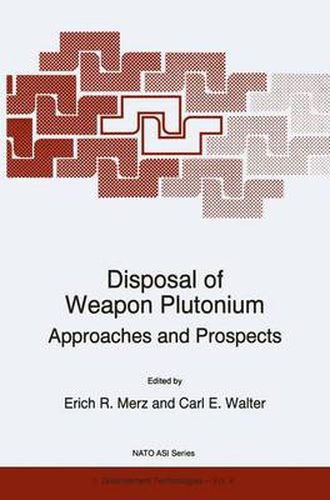Readings Newsletter
Become a Readings Member to make your shopping experience even easier.
Sign in or sign up for free!
You’re not far away from qualifying for FREE standard shipping within Australia
You’ve qualified for FREE standard shipping within Australia
The cart is loading…






This title is printed to order. This book may have been self-published. If so, we cannot guarantee the quality of the content. In the main most books will have gone through the editing process however some may not. We therefore suggest that you be aware of this before ordering this book. If in doubt check either the author or publisher’s details as we are unable to accept any returns unless they are faulty. Please contact us if you have any questions.
In the immediate term, plutonium recovered from dismantled nuclear warheads will have to be stored securely, under international safeguards where possible. One of the principal alternatives for the disposition of this plutonium is to blend it with high-level waste as it is vitrified for final disposal in a geologic repository. The high radioactivity of the resulting product provides self-shielding and ensures that the Pu cannot be separated without the development of highly sophisticated technology. This third NATO ARW on the disposal of weapons-grade plutonium discusses the non-reactor disposition option, presenting a thorough evaluation of the pros and cons. In broad terms, the workshop presents an exchange of information on waste vitrification, including technical feasibility as well as the necessary stringent safeguards. It discusses the different approaches to the optimum techniques and credible alternatives for immobilizing transuranics and fission products for disposal. It introduces new disposal techniques, in particular matrix immobilization followed by deep borehole disposal. It assesses the implications of safeguarding requirements and identifies common areas in which defined research tasks can be initiated in co-operative partnership.
$9.00 standard shipping within Australia
FREE standard shipping within Australia for orders over $100.00
Express & International shipping calculated at checkout
This title is printed to order. This book may have been self-published. If so, we cannot guarantee the quality of the content. In the main most books will have gone through the editing process however some may not. We therefore suggest that you be aware of this before ordering this book. If in doubt check either the author or publisher’s details as we are unable to accept any returns unless they are faulty. Please contact us if you have any questions.
In the immediate term, plutonium recovered from dismantled nuclear warheads will have to be stored securely, under international safeguards where possible. One of the principal alternatives for the disposition of this plutonium is to blend it with high-level waste as it is vitrified for final disposal in a geologic repository. The high radioactivity of the resulting product provides self-shielding and ensures that the Pu cannot be separated without the development of highly sophisticated technology. This third NATO ARW on the disposal of weapons-grade plutonium discusses the non-reactor disposition option, presenting a thorough evaluation of the pros and cons. In broad terms, the workshop presents an exchange of information on waste vitrification, including technical feasibility as well as the necessary stringent safeguards. It discusses the different approaches to the optimum techniques and credible alternatives for immobilizing transuranics and fission products for disposal. It introduces new disposal techniques, in particular matrix immobilization followed by deep borehole disposal. It assesses the implications of safeguarding requirements and identifies common areas in which defined research tasks can be initiated in co-operative partnership.